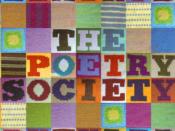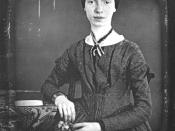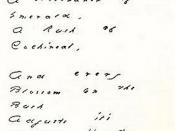Emily Dickinson's poems "Because I Could Not Stop for Death", and "I Heard A Fly Buzz-When I Died", both deal with one of life's few certainties, death.
Dickinson's intense curiosity towards mortality was present in much of her work, and is her legacy as a poet.
"Because I could Not Stop for Death" is one of Emily Dickinson's most discussed and famous poems due to its ambiguous, and unique
view on the popular subject of death. Death in this poem is told as a woman's last trip, which is headed toward eternity. This poem helps to characterize and bring death down to a more personal
level. Different from the more popular views of death being
brutal and cruel, Dickinson makes death seem passive and easy.
The theme of the poem being that death is natural and unstoppable for everybody, but at the same time giving comfort that it is not the end of a soul's journey.
The reader can recognize the poem's theme by analysing its voice, imagery, figures of speech, form, diction and especially symbolism; all of which help the reader to understand the poem's meaning. The precise form that Dickinson uses throughout the poem helps convey her message to the reader. The poem is written in five quatrains. The way in which each stanza is written i!
n a quatrain gives the poem unity and makes it easy to read. "Because I Could Not Stop for Death" starts to gives the reader a feeling of forward movement throughout the second and third quatrain. For example, in line 5, Dickinson begins death's journey with a slow, forward movement, which can be seen as she writes, "We slowly drove-He knew no haste."
The third quatrain seems to speed up as the trinity of death,


